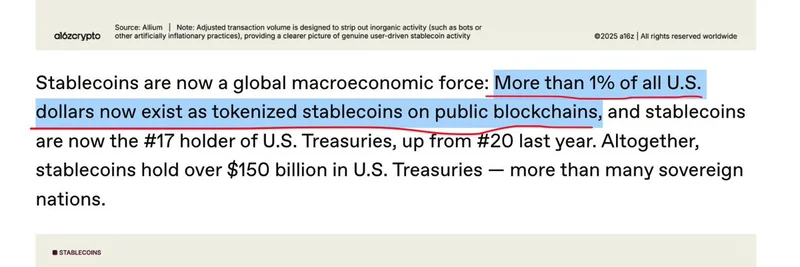Have you seen the latest buzz from the crypto world? A tweet from Adam (@Adam_Tehc) is turning heads, highlighting a mind-blowing stat from a16z crypto's State of Crypto 2025 report. It turns out that stablecoins—those digital dollars pegged to real-world assets like the US dollar—are no longer just a niche tool for traders. They're now a full-blown global macroeconomic player. Let's break this down and see what it means for the blockchain space, including the wild world of meme tokens.
The Big Reveal: 1% of US Dollars Are On-Chain
In the tweet, Adam points out something "so fucking wild": more than 1% of all US dollars now exist as tokenized stablecoins on public blockchains. That's right—out of the trillions of dollars circulating globally, a chunk equivalent to over 1% is living on-chain. Stablecoins like USDT (Tether) and USDC (USD Coin) are leading this charge, with their total supply surpassing $300 billion.
To put it simply, stablecoins are cryptocurrencies designed to maintain a stable value, usually by being backed 1:1 by reserves like cash or US Treasuries. This makes them perfect for avoiding the volatility of coins like Bitcoin or Ethereum while still enjoying the speed and borderless nature of blockchain transactions.
According to the a16z report, stablecoins have climbed the ranks to become the #17 largest holder of US Treasuries, up from #20 just last year. They're sitting on over $150 billion in these government bonds—more than many entire countries hold. For context, US Treasuries are basically IOUs from the US government, considered one of the safest investments out there. Stablecoin issuers buy them to back their tokens, ensuring that 1 USDT or USDC is always worth about $1.
Why This Matters for Global Finance
This isn't just crypto trivia; it's a shift in how money moves around the world. Over 99% of stablecoins are denominated in US dollars, which means they're actually boosting the dollar's dominance at a time when foreign central banks are shifting away from US Treasuries toward gold—for the first time in 30 years.
The report projects stablecoins could balloon to over $3 trillion by 2030, a 10x growth. That's because they're handling massive transaction volumes: over $46 trillion in the past 12 months alone, with an adjusted figure of $9 trillion after stripping out bots and inorganic activity. This rivals major payment networks like Visa or PayPal and even the US banking system's ACH network.
In places like Argentina or emerging markets, stablecoins are a lifeline, offering a stable store of value amid inflation. But even in the US, they're integrating into everyday finance, with big players like Mastercard partnering for stablecoin settlements.
Ties to Meme Tokens and Blockchain Practitioners
At Meme Insider, we're all about meme tokens—the fun, viral side of crypto that can turn a clever idea into a multimillion-dollar market cap overnight. But memes don't exist in a vacuum; they thrive on efficient infrastructure. Stablecoins are the backbone here, enabling quick swaps on decentralized exchanges (DEXs) without the hassle of fiat conversions.
Think about it: when you're trading the latest dog-themed meme coin on Solana or Ethereum, you're likely using USDC or USDT as your entry and exit ramp. This on-chain dollar boom means faster, cheaper transactions, which could supercharge meme token launches and trading volumes. As more dollars go on-chain, it opens doors for innovative DeFi protocols, NFT marketplaces, and yes, even more explosive meme supercycles.
The "on-chain supercycle" Adam mentions in his tweet? It's real. With institutional adoption ramping up—US Bitcoin and Ethereum ETFs holding over $175 billion—crypto is maturing. Public companies are now holding about 4% of Bitcoin and Ethereum supplies on their balance sheets, signaling trust from the big leagues.
Looking Ahead: Opportunities and Challenges
As stablecoins grow, so do regulatory eyes. The a16z report notes positive strides in US legislation, providing clarity that could fuel further adoption. But with great power comes great responsibility—issues like transparency in reserves (looking at you, Tether) will need addressing to keep the momentum.
For blockchain practitioners, this is prime time to dive deeper. Whether you're building dApps, trading memes, or just hodling, understanding stablecoins' macro role can give you an edge. Check out the full State of Crypto 2025 report for interactive charts and more insights.
What do you think—will stablecoins hit that $3 trillion mark? Drop your thoughts in the comments, and follow us for more on how these trends impact the meme token ecosystem.
For the original tweet that sparked this discussion, head over to Adam's post on X.


